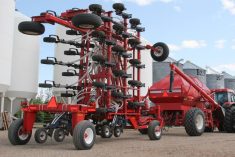The changes we’ve all been forced to endure have called my spring plans into question.
The disruption that has been thrust upon us, leaving us to choose between adapting to an ever-changing political and social landscape, enduring it, stubbornly opposing it and everything in-between has seeped into my farming plans. I’m looking at this spring differently. Arguably, we all are.
Most of us have in our tool kits an increased inventory of skills unwittingly acquired from living through a pandemic. This may be an opportunity to harness them. Maybe not.
Read Also

Gentle treatments for pain in the neck
Heading toward year-end, people unknowingly tense up against the cold and busyness, causing neck pain that can often be treated with appropriate support and gentle mobility, athletic therapist Kathlyn Hossack says.
I’m not trying to be blissfully ignorant. I am, however, acutely aware of the fact that, when nearly every stabilizing element of the structures we rely on is pulled away like Jenga pieces delicately removed from the proverbial towers we build, I believe our best response is to seize the opportunity to rebuild.
If you’re still with me, great. This will get agricultural. I promise.
I’m no longer shocked by disruption. I’m guessing many of us feel the same way. What does this all mean for our farm? When I look east, as I am doing right now, and see black bean and canola stubble on a field that is too dry to cultivate, my thoughts bend towards zero- or minimal-till.
Two years ago, the mere exploration of the concept would have seemed heretical, but now — you get it — the bar between “lunacy” and “worth exploring” has lowered considerably. If I had predicted the world we live in today in January of last year, how many of you would have believed me? Few, I imagine. “Impossible,” would have been my response.
Turns out, the world we live in today is not only possible, but actual. This realization is fertile ground worth extracting meaning from. For the record, I do not think zero- or minimal-tillage practices were ever lunacy. They were/are just unfamiliar to me.
It’s March 16 and there is no snow on the ground. Our fields are dry. Can I seed directly into canola stubble? What about fertilizer? Can we broadcast and work in with our hoe drill? What are the considerations associated with a zero-till plan on stubble?
There is always the internet, which can be a daunting tool when you ask it questions on topics so foreign and new that you don’t even have biases towards the kinds of answers you’re looking for. Starting from scratch is a weakness of online research. Confirmation bias (look it up) is, too, but that’s not for this column.
I’ve asked a lot of people about tillage, and not once did I get the impression that I was asking questions to which there are universally agreed upon answers and that I was obviously too naive or inexperienced to know what they are. Quite the opposite, in fact.
These questions and others like it seem to keep their relevance. Tillage practices seem to be a feature of farming often treated as a set of thoughts and considerations that shouldn’t change. Tillage is foundational, but we seem reluctant to play with our habit surrounding it, like, say, we would with chemical mixtures, crop varieties or machinery.
Conditions change. Trends change. Science tugs at tradition. And weather is that thing humans can’t control just yet. The practices we galvanize on our farms are subject to change.
In the wake of COVID-19, few things remain sacred. I mean this in a good way. In this case, it’s tillage. How often we cultivate, at what depth and if it should be done at all are new considerations for this farm. We’ve started to explore this over the last few years, as a way to store as much moisture as possible in our soil.
We’ve been happy with the result, though that isn’t to say we’re ready to dismiss the consideration that black soil heats up faster in spring and that a well-tilled field both looks good and makes for a great seedbed.
I can’t say for sure what changes this farm will implement this year. Right now, with warmer than aver- age temperatures, we’re trying our best to resist the urge to get the machinery out. It’s still March. Those of us who remember ’97, know that this is a historically unpredictable month. I hope we get a large serving of moisture, but I should know better and be more careful about what I ask for. Here’s to a great growing season!














